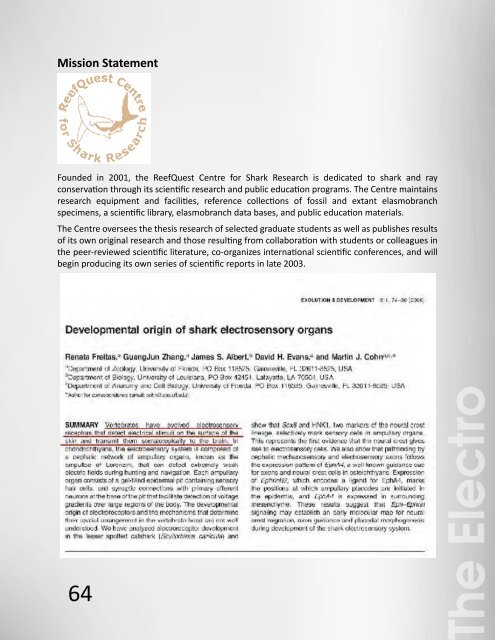The Electro Sense
The Electro Sense
The Electro Sense
- No tags were found...
You also want an ePaper? Increase the reach of your titles
YUMPU automatically turns print PDFs into web optimized ePapers that Google loves.
Mission Statement<strong>Electro</strong>reception<strong>Electro</strong>reception, sometimes written as electroception, is the biological ability to perceiveelectrical impulses. It is particularly common among aquatic creatures since conductors such assalt are more easily suspended in water than in air. It is used for electrolocation (detecting objects)and for electrocommunication. <strong>The</strong>re are no known cases of mimicry involving electroreception,though it is theoretically possible.[1]OverviewFounded in 2001, the ReefQuest Centre for Shark Research is dedicated to shark and rayconservation through its scientific research and public education programs. <strong>The</strong> Centre maintainsresearch equipment and facilities, reference collections of fossil and extant elasmobranchspecimens, a scientific library, elasmobranch data bases, and public education materials.<strong>The</strong> Centre oversees the thesis research of selected graduate students as well as publishes resultsof its own original research and those resulting from collaboration with students or colleagues inthe peer-reviewed scientific literature, co-organizes international scientific conferences, and willbegin producing its own series of scientific reports in late 2003.<strong>The</strong> <strong>Electro</strong><strong>Sense</strong>Active electrolocation. Conductive objects concentrate the field and resistant objects spread thefield.Many primitive fish such as sharks, rays, lampreys, bichirs, lungfish, coelacanths, and sturgeonshave electroreceptive senses which are believed to be derived from the lateral line sense. Thissense operates in two main modalities; active and passive.ActiveIn active electroreception, the animal senses its surrounding environment by generating electricfields and detecting distortions in these fields using electroreceptor organs. Active electrolocationis especially important in murky water, where visibility is low.Animals that use active electroreception include the weakly electric fish, which generate small(typically less than one volt) electrical pulses using an organ in the tail consisting of two to fiverows of modified muscle cells (electrocytes).Weakly electric fish can discriminate between objects with different resistance and capacitancevalues, which may help in identifying the object. <strong>The</strong>y can also communicate by modulating theelectrical waveform they generate; an ability known as electrocommunication.[2]Active electroreception typically has a range of about one body length, though objects with anelectrical resistance similar to that of the surrounding water are nearly undetectable.PassiveIn passive electroreception the animal senses the weak bioelectric fields generated by otheranimals. Animals that use passive electroreception include sharks and rays.64 65
















